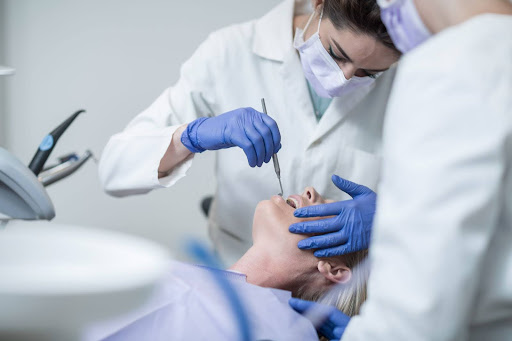Tooth Extraction for Braces: Do You Need It?
A common worry with braces is whether teeth must be pulled to make space for proper teeth alignment. While not everyone undergoing orthodontic treatment requires tooth extraction for braces, it can sometimes be the best option for creating the perfect smile. Let’s find out when and why tooth extraction might be necessary, and what to expect if it is.
Why Tooth Extraction May Be Necessary for Braces
One of the primary reasons for tooth extraction is overcrowding. If your teeth are too large for your jaw, or your mouth is too small, braces alone might not create enough space to properly align your teeth. By removing certain teeth, your orthodontist can make room for your remaining teeth to shift into the correct position, ensuring optimal alignment.
In some cases, you might also need extractions if your teeth protrude. When your front teeth stick out, removing teeth can help retract them into place, improving both appearance and bite function.
Additionally, if your wisdom teeth or other molars are impacted or pose future risks, extraction may be necessary to prevent them from interfering with your braces.
Alternatives to Tooth Extraction in Orthodontics
Tooth extraction is not always the first option. Modern orthodontics offers several alternatives. For example, your orthodontist might suggest interproximal reduction — a technique that involves slightly reshaping the sides of your teeth to create more space.
Another option is using palatal expanders to widen the upper jaw, particularly for younger patients. In some cases, clear aligners like Invisalign can correct mild overcrowding by molar distalisation without the need for tooth removal.
(Source: Envato)
Understanding the Tooth Extraction Process
If extraction is the best course, it is important to know what to expect. A simple extraction involves loosening a visible tooth and gently removing it with forceps. This is typically a fast procedure performed with local anaesthetic.
In more complex cases, such as with impacted teeth, a surgical extraction may be required. This requires creating a small cut in the gum tissue to extract the tooth. The process remains painless due to the anaesthetic, and recovery is straightforward with proper care.
But which teeth are extracted?
Typically, premolars are removed because they allow space for the front teeth to move back and the bite to correct itself. In rarer cases, molars or other teeth may need to be extracted based on your specific orthodontic needs.
Factors That Influence Tooth Extraction Decisions
There are several factors your dentist considers before recommending extraction. The extent of overcrowding, the position of your teeth, your bite alignment, and even the shape of your face all play a role in determining whether tooth removal is necessary.
The number of teeth needing extraction varies. In some cases, only one or two teeth are removed, but more complex cases may require four extractions.
Age is also a factor. Children tend to have more flexible bones, meaning less invasive options like palatal expanders can often prevent extraction. For adults, where the jaw is fully developed, extraction might be more likely to create the necessary space.
Post-Extraction Care and Recovery
After the extraction, proper care is crucial for healing. Most patients recover within a week. Using ice packs to reduce swelling, taking prescribed pain relief, and following aftercare instructions will speed up the healing process. Avoiding hard foods and rinsing your mouth with salt water can also prevent complications.
It is important to allow the extraction site to heal before continuing with braces. Your orthodontist will monitor the healing process and plan your next steps accordingly.
(Source: Envato)
Common Questions About Tooth Extraction and Braces
1. Is extraction always required before braces?
No, tooth extraction for braces is only necessary in cases of severe overcrowding, protruding teeth, or impacted molars. At The Braces Practice, we always adopt the most minimally invasive treatment plan where possible.
2. When and why might dentists recommend extraction for braces?
Dentists recommend extraction when space is needed to allow teeth to shift into alignment or when impacted teeth could interfere with the treatment.
3. Are there risks associated with tooth extraction for braces?
While generally safe, potential risks include infection, prolonged healing, or changes in bite and facial aesthetics. Your orthodontist will take steps to minimise these risks.
4. What should I do if I experience complications after extraction?
If you experience unusual pain, swelling, prolonged (more than 24 hours) bleeding after extraction or fever, contact your orthodontist immediately. They can assess the situation and provide necessary treatment to address any complications.
5. What lifestyle changes should I make after tooth extraction?
After extraction, it is advisable to stick to soft foods for a few days, avoid strenuous activities, and maintain good oral hygiene without disturbing the extraction site to ensure proper healing.
6. Can I get braces on the same day as tooth extraction?
In most cases, braces are placed after the extraction site has healed, typically about one to two weeks later, to ensure a smooth treatment process.
7. What are the alternatives to tooth removal?
Alternatives include interproximal reduction, palatal expanders, and clear aligners. Your orthodontist will assess your case to determine the best approach.
Impact of Tooth Extraction on Facial Appearance and Health
One common concern is whether tooth extraction will change your facial structure. While it is true that extraction can slightly alter your profile, it is typically minimal and done in a way that enhances facial harmony. In fact, correcting overcrowding can improve your smile’s overall balance.
Some people worry about breathing or airway issues after tooth extraction. However, your orthodontist will ensure that any changes made to your bite or jaw structure will not impair your breathing. In cases where airway health is a priority, non-extraction methods are explored first.
Conclusion
While tooth extraction for braces can be an intimidating thought, it is often the key to achieving a well-aligned, beautiful smile. It can prevent long-term oral health issues, enhance the effectiveness of your orthodontic treatment, and provide space for a healthier bite. Always consult with your orthodontist to explore all available options and make the right decision for your smile.
Need braces? Get in touch with The Braces Practice for more information!







